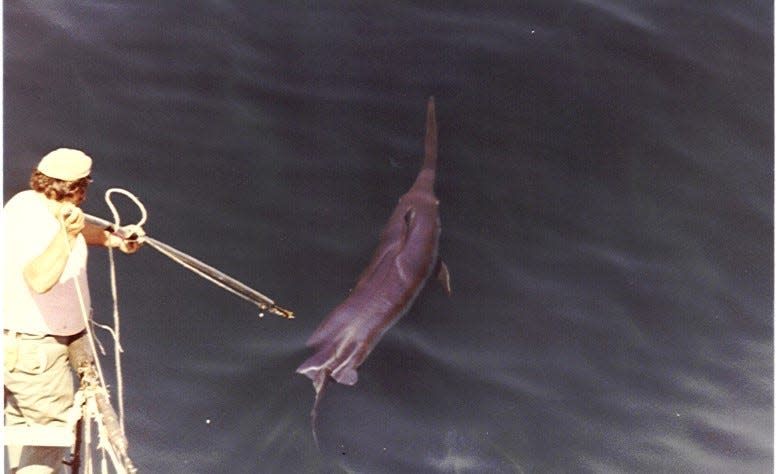Swordfish sightings: Apex predator, with few enemies, is not like the cartoon
Recently, I had a report that a swordfish was spotted in the Gulf of Maine by one of the party fishing boats out of Hampton Harbor.
This surprised me but on second thought, the fishery is above its target biomass and the water temperatures are warmer.
Swordfish are a highly recognizable cartoon character, for years, leading people to believe that they spear their prey with their bill to feed. If they did “spear” their prey, they would have a fish at the end of their bill and never be able to feed as their mouth is at the other end. So, what is the true nature of swordfish apart from our cartoon adaptations?

First, swordfish are a large fish, according to the National Oceanic and Atmospheric Administration (NOAA) website, reaching 10 feet in length and up to 1,165 pounds. Their average size within the New England fishery is about 50 to 200 pounds. They are a broad fish with a crescent-shaped tail and large dorsal fin. Their most recognizable attribute is their flat broad “bill” extending from their head. Thus, the name swordfish.
The young have scales and teeth, but these are soon lost as they mature. A fully mature swordfish has neither teeth nor scales. They also have unique eye muscles and circulatory system heat exchange system that keeps the brain heated above the ambient water temperature. These adaptations allow them to hunt prey in depths and colder water.
More: Here's why you won't find sea turtles at Hampton Beach
Swordfish spawn several times from south of the Caribbean during the winter months on up through southern Florida into the spring and summer while migrating north along the Eastern Coast of the U.S. up to the Grand Banks off Newfoundland. They appear to be wanderers occurring on both sides of the Atlantic and every ocean except the Arctic and Antarctic.
Swordfish often are seen jumping out of the water. This behavior is believed to be a way for them to rid themselves of remora and parasites, a host of which inhabit their outer skin and muscles.
Harbor seals a plenty: Great for tourists, not the ecosystem
They are an apex predator with few enemies. They feed by swimming into a school of unsuspecting fish or squid, whipping their bill back and forth in a frenzy stunning and injuring as many as possible, eating as many as they can. These animals have few enemies, occasionally the young are attacked by mako sharks, larger fish like marlin, tuna, mahi mahi and killer whales. Of course, we need to keep humans in the food chain as we do enjoy swordfish steaks.
Up until the 20th century, swordfish were not a valuable food fish in the United States. Fishing in earnest began in the mid-20th century and they were caught with harpoons.
More recently most of the landings of swordfish are made using long lines and pelagic gillnets. In the Gulf of Maine (according to “Fishes of the Gulf of Maine” 3rd edition), 95% of the swordfish are caught by long lines.
Moon snails: The unique creature that eats other snails and clams
The average pelagic longline is 28 miles long with baited hooks attached to the line with long leaders. In the U.S., all pelagic long lines are required to use circle hooks. Circle hooks are a fairly new innovation of hook which reduces the chance that a fish will swallow the hook and die. These hooks allow the fishermen to safely release undersized fish and bycatch without damaging the fish. Survival rates for released fish are greatly increased. These hooks are also available for almost any recreational fishery. I personally use them whenever I can. If you would like more information on circle hooks, please look on the N.H. Fish and Game website. When purchasing them, remember to request inline circle hooks.
Some tackle shops sell offset circle hooks which will not work to help the survivability of the discards.
Decorator crabs: The amazing spider crustaceans found in Hampton Beach tidepools
The Northwest Atlantic swordfish stocks are doing quite well and are highly regulated by NOAA Fisheries. Permits are required to land swordfish either commercially or recreationally. For decades they have been an exciting fish to catch and play recreationally and a delicious fish on your plate.
There was a harpooned swordfish brought into the Yankee Coop in Seabrook in 2021 that was caught just southeast of the Isles of Shoals. I believe that it may have been the only swordfish ever landed there. On reflection, with warming water temperatures in summer and fall, we should probably expect to see more swordfish coming our way in the future.
Ellen Goethel is a marine biologist and the owner of Explore the Ocean World at 367 Ocean Blvd. at Hampton Beach.
This article originally appeared on Portsmouth Herald: Swordfish sightings in the Gulf of Maine: Warming water may be the cause

